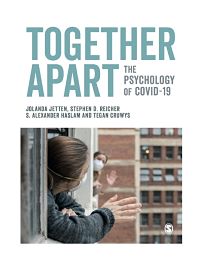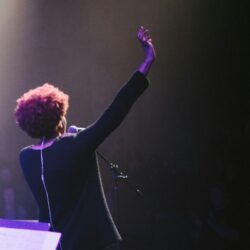Inequality and COVID-19: Excerpt from ‘Together Apart’
Social distancing is a privilege. It means you live in a house large enough to practice it. Hand washing is a privilege too. It means you have access to running water. Hand sanitizers are a privilege. It means you have money to buy them. Lockdowns are a privilege. It means you can afford to be at home. Most of the ways to ward the Corona off are accessible only to the affluent. In essence, a disease that was spread by the rich as they flew around the globe will now kill millions of the poor. (Anonymous Indian doctor, cited by Tomazin, 2020).
The poor and the stigmatized in society are more vulnerable to disasters than the affluent and privileged. This is not a new observation. For example, in the aftermath of Hurricane Katrina in New Orleans, it became clear that poor and black residents were disproportionately affected by the floodwaters. The sociologist Erikson captured this well, observing “The portion of the New Orleans population that lives below sea level and the portion that lived below the poverty line turned out to be largely the same” (Erikson, 1976, Prologue). Accordingly, as the opening quote to this chapter suggests, when it comes to understanding whose health and financial situation has been most negatively affected by COVID-19, we need to focus on the disadvantaged in society, not the advantaged.
COVID-19 targets and exacerbates group-based disadvantage
One powerful explanation of the unequal impact of the virus relates to the resources available to the “haves” and the “have-nots”. For example, those on lower wages are less likely to engage in physical distancing, for the simple reason that they are unlikely to be able to work from home and unable to avoid crowded public transport when getting to work (Ogbunu, 2020). Indeed, location data from 15 million U.S. phone users revealed that limiting movement was a luxury low-income people were less likely to be able to afford. While everyone moved around less once physical distancing measures were introduced, wealthier people were more likely to stay at home sooner and more often. This effect was most pronounced during the work week, which suggests that this difference was due primarily to the fact that people with higher incomes tended to have greater flexibility to work from home. More affluent people had a physical distancing “head start” — reducing their exposure to the virus at a crucial point in time and hence diminishing their risk of falling ill (Valentino-De Vries et al., 2020).
Moreover, low-income employees are less likely to be in secure employment than their high-income counterparts, and less likely to benefit from protective equipment and measures that allow them to do their work safely (Scheiber & Conger, 2020). Even if a person’s job can hypothetically be done remotely, to work effectively from home one needs to have high-speed internet and an appropriate office space. Again, this is more likely to be true the more affluent one is (Reeves & Rothwell, 2020). At the household level, a person’s wealth determines the extent to which they can stockpile food and other necessities, and therefore the frequency with which they need to leave their houses and be exposed to the virus (Reeves & Rothwell, 2020).

In summary, like any disaster, COVID-19 has hit the most vulnerable the hardest. As Erikson (1976) notes, simple geography partly explains why the vulnerable end up bearing the brunt of natural or human-made disasters:
Tsunamis do not seek out the poor; the poor are shoved out to those low-lying areas where the land meets the sea. Earthquakes do not seek out the ill-housed; they strike evenly at all of the structures in their way, but do the most damage to the frailest and most shoddily built of them, the ones in which the needy have been invited to live. Toxic waters do not seek out the least protected; they are deposited on the same parcels of land where the poorly protected, in their turn, have been deposited. (Erikson, 1976, Prologue)
While this is true, it is important to add that those who are vulnerable do not “find themselves” in those vulnerable places by accident. Indeed, the poor have not been ‘deposited’ on dangerous dumping grounds through sheer back luck. To understand what put and kept them there, we need to understand the dynamics of intergroup power and status that legitimize and consolidate their disadvantage (Tajfel & Turner, 1979). As Ashwin Vasan, a public-health professor at Columbia University observed about COVID-19, “People want to talk about this virus as an equal opportunity pathogen, but it’s really not … It’s going right to the fissures in our society” (cited in Valentino-De Vries et al., 2020).
In short, the harm caused by COVID-19 differs as a function of status and power inequalities in any given society. The more division there is, the more harm it does.
Group-level disadvantage compromises health and hence resistance to COVID-19
While economic inequality limits the ability of those at the bottom of a status hierarchy to materially protect themselves against COVID-19, there is another reason why it is the poor, the stigmatized and minorities who are most vulnerable to the virus. This relates to the oft-observed social gradient in health whereby people are more likely to be healthy and less likely to have underlying health conditions if they are more affluent, white, and living in a Western country (Haslam et al., 2018; Marmot, 2015). In the context of COVID-19, this means, for example, that because pre-existing health conditions such as diabetes, respiratory conditions and heart disease are more prevalent in disadvantaged groups, it is more likely that members of those groups will be harmed (and killed) by the virus (Reeves & Rothwell, 2020).
Why do the disadvantaged have chronically poorer health than the advantaged? There are a number of reasons, the most obvious being that poverty reduces people’s access to relevant resources (including treatment and advice; see Haslam et al., 2018, for a detailed discussion). From a social identity perspective, what is particularly relevant is that disadvantage typically goes hand in hand with being the target of stigma (Jetten et al., 2017). This means that the negative effects of disadvantage on health are partly grounded in group-based discrimination and exclusion on the basis of group membership (Paradies et al., 2015; Schmitt et al., 2014). Because of this, we expect that membership of stigmatized groups (e.g., those centering on ethnicity and social class), will have its own independent negative impact on people’s ability to cope with COVID-19. For example, it is clear that in the U.S. a combination of poverty, discrimination, and low-quality care serves to create ‘a perfect storm’ for African-Americans following COVID-19 infection. In the state of Louisiana this has meant that while African-Americans constitute just a third of the general population they have suffered more than 70 per cent of COVID-related deaths (ABC News, 2020).
Inequality will almost certainly increase in the aftermath of the COVID-19 crisis
It is not just that infection rates differ for the haves and the have-nots. The longer-term economic consequences of COVID-19 will also vary widely for those in different socio-economic groups. As Torsten Bell of the Resolution Foundation noted, “the virus doesn’t discriminate between people but the accompanying economic shock certainly does” (The Economist, 2020).
There is good evidence that, in the aftermath of most disasters, inequality (i.e., the gap between the poorest and the wealthiest in society; Jetten et al., 2017) increases and deepens. For example, research showed that in the years following the disastrous flooding of the Brisbane River in 2011, the difference in annual income between those on low and middle incomes increased by AU$7,000 a year (Ulubasoglu, 2020). The reasons for this intensification of inequality are complex; one is that lower-income workers are most likely to be temporarily unemployed because of a disaster (e.g., in the case of COVID-19 those in the tourism and hospitality industry), and are not able to easily make up for the income lost over this time. Furthermore, employees on casual contracts and with little job security are more likely to be without income for a considerable period. Lower-income earners are also less likely to be insured for disasters and, consistent with Erikson’s (1976) reasoning, are more likely to live in hazard-prone areas. This means that they are not only more likely to be harder hit by a disaster but also likelier to have limited means to recover from it. In contrast, those on full-time contracts and with higher incomes are likely to be less affected. Indeed, sometimes they may even benefit financially from disaster (e.g., because lobbying enhances the likelihood that financial support systems will be developed with them in mind; Beaini & Ulubasoglu, 2019).
Group-based inequality undermines social solidarity
The foregoing discussion suggests that economic dynamics are often a key cause of deepened income inequality following disasters. In the case of COVID-19, for example, it seems likely the businesses and communities that benefit most from financial recovery packages will be those that are most prosperous (Kristof, 2020; Ulubasoglu, 2020). Importantly, these dynamics are also partly psychological; social identity theorizing suggests that they will often be grounded in collective-level processes and intergroup relations. This is because some of the key defining features of communities and countries experiencing high levels of economic inequality are low in cohesiveness and characterized by strong ‘us-versus-them’ dynamics (Jetten et al., 2017; Jetten & Peters, 2019; see also Chapter 18). Furthermore, with high inequality comes low trust and high competitiveness — both ingredients that undermine a coordinated response to a disaster.
As we saw in Section C, whether a community bands together or falls apart in the face of a disaster depends very much on whether people have a strong sense of shared identity before the disaster (Muldoon et al., 2019). In the context of a contagious virus where the actions of others determine whether infection spreads or not, issues of trust and solidarity are likely to be especially important (Rao & Greve Insead, 2018). Given its capacity to undermine trust, pre-existing inequality will be one of the key determinants of whether chaos or solidarity prevails in the wake of disaster.
Practically speaking, does this mean that communities and societies with high levels of inequality are doomed and that, by definition, they will be more harmed by COVID-19 both in the immediate and the longer term? No. High inequality does not determine outcomes, but is instead an obstacle in the path to recovery. Accordingly, even though inequality is often deeply embedded in societal structures and therefore not easily reduced, it is instructive to consider ways in which its negative effects on solidarity, trust, and community cohesion can be countered. The lessons of previous sections on how building shared social identity can enhance effective leadership, social connectedness, and solidarity in the face of the pandemic are critical when developing policy around these issues.
This recommendation to focus on building group-based ties sits well with the conclusions of Rao and Greve Insead (2018). In their analysis of community resilience in the aftermath of the Spanish flu, they conclude that, because contagious diseases undermine cooperation in society, rebuilding needs to focus on boosting community cooperation and identification:
The typical response to pandemics includes isolation and treatment, home quarantines, closure of schools, cancellation of large-scale public meetings, and other steps to reduce social density. While these immediate responses are entirely practical, policy planners should also consider how a pandemic impairs the social infrastructure of a community over the long term, and undertake initiatives to foster the building of community organizations. After all, if it is sociable communities that survive disasters by helping themselves, investments in enhancing the social infrastructure of communities too merit consideration.
We could not agree more.
Explore the section of Together Apart on intergroup relations
Prejudice and Discrimination| Yuen J. Huo
Inequality | Jolanda Jetten
Common Identity and Humanity | John F. Dovidio, Elif G. Ikizer, Jonas R. Kunst, & Aharon Levy
Societal Polarization | Charlie R. Crimston & Hema Preya Selvanathan



























































































